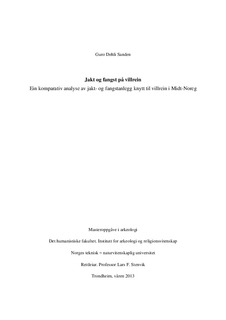| dc.contributor.advisor | Stenvik, Lars F. | nb_NO |
| dc.contributor.author | Sanden, Guro Dehli | nb_NO |
| dc.date.accessioned | 2014-12-19T13:04:30Z | |
| dc.date.available | 2014-12-19T13:04:30Z | |
| dc.date.created | 2013-07-03 | nb_NO |
| dc.date.issued | 2013 | nb_NO |
| dc.identifier | 635249 | nb_NO |
| dc.identifier.uri | http://hdl.handle.net/11250/242927 | |
| dc.description.abstract | This thesis examines the distribution of prehistoric hunting structures for reindeer in the mountain area of central Norway. This study focuses on two different main types of hunting structures: stone bricked archery position and pitfalls. Pitfalls can be divided in two groups: stone bricked pitfalls or pitfalls dug in the ground. This thesis wants to review a theory introduced by Øystein Mølmen, who has suggested that there exist two main types of hunting structures. One type consists of a dense concentration of archery positions in a terrain stripe of the coastal mountain area from Geiranger in south to Sunndal in the north. In the mountain area further east, the dominant hunting structures consists however of large pitfall trapping systems.
As a part of this study, all known information concerning hunting structures for trapping reindeer in central Norway will be presented on a map showing various concentration and distribution of the two main types of hunting structures within the research area. This information will be used to review the distribution of the different types of hunting structures, and where the boundary between the different hunting structures may be identified. Interpretation will focus on the location of the hunting structures in relation to known migration patterns and reindeer behavior to see if these elements can explain how the hunting might have taken place and why there exist a different distribution of hunting structures in the western mountain area compared to the east. The age of the hunting structure will also be discussed. Have the archery positions and the pitfalls been used in different periods, are they contemporary or perhaps reused over a longer time period?
In this study, potential variations in social organizing behind the hunt and whether the hunting structures might have been used by different culture groups will also be mentioned. This might explain the different geographical distribution of hunting structures within the research area. In this connection various aspects regarding an ongoing ethnicity debate and conflict in the Trollheimen area will be mention. The conflict concern whether the Sami people have a historical claim to use the mountain area of Trollheimen as grazing land for domesticated reindeer, and how the archaeological science works and stands in this political conflict. | nb_NO |
| dc.language | nor | nb_NO |
| dc.publisher | Norges teknisk-naturvitenskapelige universitet, Det humanistiske fakultet, Institutt for arkeologi og religionsvitenskap | nb_NO |
| dc.subject | reinsdyr | no_NO |
| dc.subject | reinsdyrjakt | no_NO |
| dc.title | Jakt og fangst på villrein: Ein komparativ analyse av jakt- og fangstanlegg knytt til villrein i Midt-Noreg | nb_NO |
| dc.title.alternative | Hunting reindeer in the past: A comparativ analysis of hunting structures for reindeer in the sentral Norway | nb_NO |
| dc.type | Master thesis | nb_NO |
| dc.source.pagenumber | 114 | nb_NO |
| dc.contributor.department | Norges teknisk-naturvitenskapelige universitet, Det humanistiske fakultet, Institutt for arkeologi og religionsvitenskap | nb_NO |
